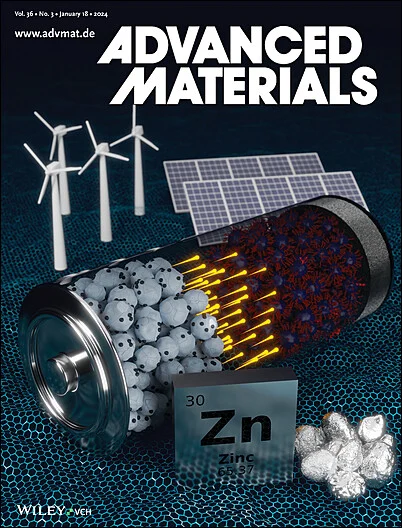Genetic Surfaceome E. coli Reprogramming Enables Selective Water Oxidation.
IF 26.8
1区 材料科学
Q1 CHEMISTRY, MULTIDISCIPLINARY
引用次数: 0
Abstract
Programming catalytic behavior at the microbial genome level is a frontier in synthetic biology with direct impact on bioelectrocatalysis. A key challenge is the coordinated control of gene expression, localization, folding, and cofactor maturation required to achieve proper bioelectrocatalytic activity. Here, a synthetic operon in Escherichia coli is engineered to reprogram its surfaceome for selective water oxidation. Using orthogonal IPTG-inducible control and codon-optimized expression, a fungal bilirubin oxidase (BOD) displayed at the cell surface is produced by ice nucleation protein anchoring (BOD-E. coli). Post-overexpression copper catalytic site reconstitution provides an active holoenzyme. The developed engineered living material performs water oxidation at near-zero overpotential (27 mV at pH 9.1), with complete suppression of the oxygen reduction reaction. These results show how regenerable microbial platforms can be designed for selective catalysis and artificial photosynthesis.基因表面体大肠杆菌重编程实现选择性水氧化。
在微生物基因组水平上对催化行为进行编程是合成生物学研究的前沿,对生物电催化有直接的影响。一个关键的挑战是协调控制基因表达、定位、折叠和辅因子成熟,以实现适当的生物电催化活性。在这里,大肠杆菌中的一个合成操纵子被改造为对其表面体进行选择性水氧化的重编程。利用正交iptg诱导对照和密码子优化表达,通过冰核蛋白锚定(BOD- e)在细胞表面产生了真菌胆红素氧化酶(BOD)。杆菌)。过表达后铜催化位点重构提供了一个活性全酶。开发的工程活性材料在接近零过电位(27 mV, pH 9.1)下进行水氧化,完全抑制氧还原反应。这些结果表明如何设计可再生微生物平台用于选择性催化和人工光合作用。
本文章由计算机程序翻译,如有差异,请以英文原文为准。
求助全文
约1分钟内获得全文
求助全文
来源期刊

Advanced Materials
工程技术-材料科学:综合
CiteScore
43.00
自引率
4.10%
发文量
2182
审稿时长
2 months
期刊介绍:
Advanced Materials, one of the world's most prestigious journals and the foundation of the Advanced portfolio, is the home of choice for best-in-class materials science for more than 30 years. Following this fast-growing and interdisciplinary field, we are considering and publishing the most important discoveries on any and all materials from materials scientists, chemists, physicists, engineers as well as health and life scientists and bringing you the latest results and trends in modern materials-related research every week.
 求助内容:
求助内容: 应助结果提醒方式:
应助结果提醒方式:


